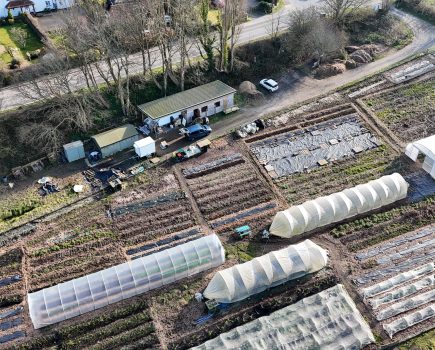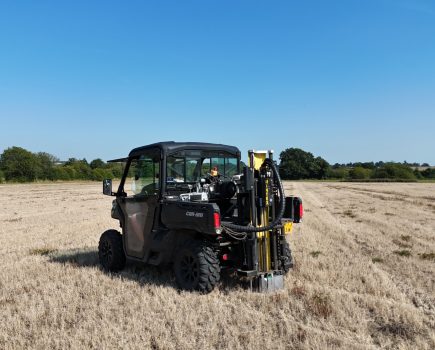Richard Shepherd-Baron investigates farm diversification, beginning with a government definition: “When a farm breaks out from traditional farming by adding money-making activities. This can be an expansion of agricultural activities into new innovations or moving into non-agricultural business types.”
Diversifying your farm can involve anything from changing the actual production from your land to starting a bed and breakfast or catering business in a disused barn or setting up some tourist or recreational activity on the land; the list of opportunities is almost endless.
There are examples across the country of farms going into the most unlikely businesses with huge success. A perfect example was in 1970 when a Somerset dairy farmer near Glastonbury, Michael Eavis, decided to have a little music event on his land (1,500 attendees; tickets £1 each including free milk from the farm) – and look what that turned into!
In these current times of ever-increasing input costs and difficulties with prices for their produce, farmers and landowners are looking now for new ways to create additional income in order to stay in business and provide a viable future.
Diversification is considered to offer considerable scope for improving the financial stability of many farm businesses. In addition, a good number of farm diversifications can provide benefits for the wider rural economies and communities by encouraging and providing additional job and supply opportunities. Increasing numbers of the general public are becoming more passionate about “buying local” and “reducing their carbon footprint”, making this an encouragement to establish a diversification.
DEFRA has produced some statistics recently which show that 68% of farm businesses in England had some diversified activity in 2021/22. Over the past five years, this proportion has remained fairly stable, but it represents an increase of 5% since 2011/12.
The main diversified activity is letting out buildings for non-agricultural use, with almost half (47%) of English farms engaging in this activity. The second most common form of diversified activity in England has been generating solar or wind energy, at 22% of farms in 2021/22. This, however, has not always been the case, as in 2011/12 the proportion of farms producing solar energy was only 1%. This represents an increase of 21% in ten years. This is likely the main driver in the increased variability in diversified activities. No other activity has an uptake of more than 13% to date.
Delving further into DEFRA’s figures, in 2021/22 farms with diversified activities had an average diversified enterprise income of £24,000, with the most profitable form of diversified activity being the letting of buildings. Tourist accommodation/catering and processing/retailing of farm produce both had a similar enterprise average income at £15,100 and £14,400 respectively.
Surprisingly, the figures show that income from solar energy was quite low at £4,900, equal to farms engaging in sports and recreation. Of course, this could be accounted for by the fact that many farms use the solar energy for their own cost reduction purposes and are not connected to the National Grid for sales.
Farms engaging in diversification have a great variation in how much they depend on this part of their business. In 34% of farm businesses with diversified activities, revenue from these accounted for at least a quarter of their income, while for 19% this income accounted for more than half their farm business income. Of course, certain types of farming (combinable crops for example) showed a rise in income last year, so this will affect the overall percentages.
The main advantages of farm diversification include taking on new activities that family members and employees are going to enjoy as well as providing an increased income and a more secure future.
While most of us are generally resistant to change, learning new skills is a considerable benefit to mental health as well as, hopefully, the income of the farm. The new business and skills can subsidise and boost the ways in which the traditional farming activities are carried out; by expanding your activities you not only broaden your outlook but also your contacts. You become better prepared to look at other ventures which can be of benefit. In addition, you have a business that is not reliant on only one income stream, with all the risk that is involved in today’s difficult and uncertain times for farming.
Having made the decision to look seriously at diversifying your business, you will need to work out the business plan, arrange the necessary finance and investigate insurance needs, research the market as well as your sales and marketing strategies and make sure there are no planning or legal difficulties. All these things will take up a great deal of time but are vital to make sure you are on the right track.
Running a farm and setting up a new venture at the same time is not without its challenges; talking to people who have already started new ventures on their farm is very helpful, as is discussion with various planning and financial experts.
Muller Property is a leading company in the development of farmland for various projects and Colin Muller commented recently: “Success in farming is a long-term game – as in planning, especially if on the edge of an urban area. Farmers generally don’t start early enough on planning for the land and the potential for its development – if not now, when? It’s important to engage with the planners early on, asking the right questions of the right people, as probably no one in local authorities understands farming.”
The NFU has a planning company –
CT Planning – to help its members, and Chris Timothy agrees that planning applications are taking a long time to process nowadays with the shortage of staff in planning departments; he said: “The whole system is under considerable pressure.”
Many farms have a large number of unused assets in the form of buildings and, as was shown in the DEFRA figures, letting these out for storage, small industrial units, etc is a very popular way to provide additional income. Some old farm buildings can be truly attractive and are thus ripe for development into residential property, retail outlets or for catering or hospitality of one sort or another.
If the farm fortuitously happens to be near a major tourist attraction, then there will already be a regular visitor stream to tap into. However, many local authorities have very firm plans and opinions on converting farm premises to non-agricultural use and this is where the use of a skilled and experienced professional has huge benefits.
One way of looking at new ideas is to base them on the skills you have already in your farming business – yourself, your family or existing employees. For example, if one member of the family is heavily ‘into’ horses, then perhaps this could be a possible new business venture to use old buildings or marginal land. If somebody else is very skilled at catering then this could be the avenue to go down with hospitality – perhaps a wedding or events venue? A hobby may be collecting and restoring old farm machinery and this could be the basis for a small museum and visitor attraction with shop and catering.
Of course, the financial implications of all this are important and this is a crucial part of planning for a new venture and making it into a reality. Many farmers have said that the lack of access to finance is a potential barrier.
To start a successful diversification business, you do need to have a strong core business in the first place. If the diversification is seen as a lifeline to save a weak main business, then diversifying for the sake of it could well put the whole operation at risk. In addition, the application for funding will need to be accompanied by accounts – three years of losses is not what banks want to have presented to them.
To help with your own financial input or that from a bank or other financial institution, from 1 April this year the Rural England Prosperity Fund (REPF) becomes available, running through until March 2025. The government has committed £110 million to help improve rural economies. This is effectively a replacement for the previous LEADER and Rural Growth programmes under the Rural Development regulation that ended last year.
It will provide capital grants for a number of areas: farm diversification, including tourism enterprises; the conversion of redundant farm buildings for other uses; food processing and marketing ventures; boosting “rural connectivity” through broadband projects; community projects such as village halls, public access, etc.
It will be operated by local authorities, which is a different approach to previous grant schemes and one hopes that they are already geared up to deal with applications.
Researching the potential market for your shiny new idea is vital. You need to be certain there is actually a market for your products or services, that you can put together the whole scheme and that you can make a profit. Again, talking to other people who have already gone down the diversification route will highlight any pitfalls and provide useful advice to help decision making on the new project.
Marketing and promoting your new enterprise needs careful thought and planning. Creating a website requires special skills and you should consider what images you use to present everything in the most attractive way, with additional details about the products or services on offer.
For potential customers nowadays, the website is very often the first thing they see about a business and it should tell them everything they want to know in an attractive, friendly and up-to-date manner – just think about the websites you use yourself and which ones you are impressed by.
In addition, it will pay to become involved with platforms such as Facebook, Instagram and TripAdvisor. NFU Mutual’s senior propositions manager, farming and commercial, Chris Walsh is clear in his advice about promoting a new venture: “Don’t forget to shout about the value and quality of your product or service. It’s vital to stand out for the right reasons. A good way to do this is to be clear about why or how your product or service is unique.
“For example, does it have a sustainability story that will engage consumers? Understanding your typical customer can help ensure your marketing efforts are targeted. For instance, if you’d like to sell directly to customers, researching local events as promotion opportunities could be a good starting point. If you’re targeting local businesses, offer to tailor your product or service to complement their overall style or theme.”
Another area which needs thought is the location of the farm. Many rural areas have very poor road access, broadband and mobile coverage. These could be vital for certain types of business and you do need to check that what you need is or will be available. There could also be a cost implication here, perhaps for the installation of new lines or satellite broadband. Research into what other people have done to obviate these sorts of difficulties will be of great help.
Diversifying is not for everyone, and while not every farmer or landowner has moved on into a diversification programme, those that have done this are finding that the new income streams have helped them keep their businesses secure with increased resilience in these times of financial uncertainty.
Read our full diversification feature
For more like this, sign up for the FREE South East Farmer e-newsletter here and receive all the latest farming news, reviews and insight straight to your inbox.







